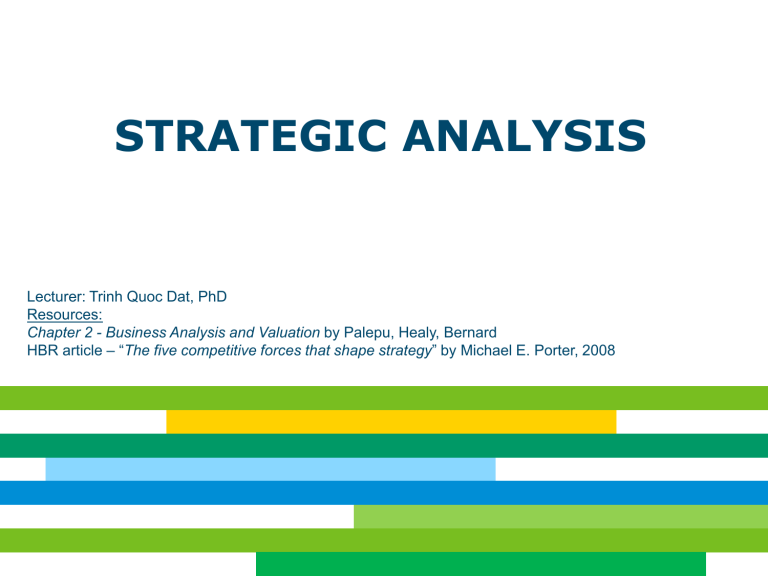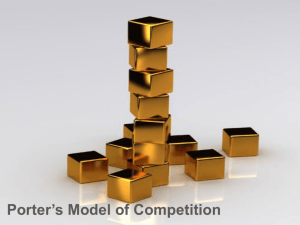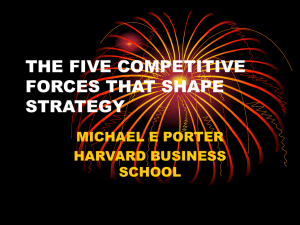
STRATEGIC ANALYSIS Lecturer: Trinh Quoc Dat, PhD Resources: Chapter 2 - Business Analysis and Valuation by Palepu, Healy, Bernard HBR article – “The five competitive forces that shape strategy” by Michael E. Porter, 2008 LEARNING OBJECTIVES Understand the business through economic, industry, and competitive analysis, which lays the foundations for valuation process and assumptions In focus : Porter’s five forces model for industry analysis Issues: What is an attractive industry? How do you evaluate the attractiveness of an industry? What is the strength of a firm's competitive position in an industry? What role does market structure play? 2 REVIEWING … Some golden rules for valuing a business • One does not buy a stock, one buys a business • Value depends on the business model, the strategy • Good firms can be bad buys: avoid the risk of paying too much for a stock (ex. paying too much for growth, “new knowledge”, etc..) • Don’t mix what you know with speculation • Stick to your beliefs and be patient, prices gravitate to fundamentals, but that can take some time 3 VALUATION APPROACH – THE BIG PICTURE 4 THE VALUATION PROCESS Understanding the business Strategic analysis Forecasting company’s performance Accounting analysis Financial statement analysis Valuation techniques applied Intrinsic value Vs. Market price 5 STRATEGIC ANALYSIS In general, it is to answer the following 4 questions: Industry analysis How attractive is the industry in terms of offering prospects for sustained profitability? Competitive analysis Competitive strategies What is the company’s competitive position? What is the company’s competing strategies? Execution How well has the company executed its strategies for performance improvement 6 INDUSTRY ROA (2008) Network and other communications 13.1% Pharmaceutical 11% Food services 11.4% Food consumer products 6.8% Chemicals 5.5% Computer, office equipment 5.4% Utilities: Gas and electric 2.9% Entertainment -3.1% Real Estate -11.8% Airlines -14% Source: www.money.cnn.com What determines the profitability of different industries? 7 PORTER: INDUSTRY ANALYSIS Porter’s Five Forces define an industry’s structure and shape the nature of competitive interactions within an industry 8 PORTER FIVE FORCE MODEL THREAT OF NEW ENTRANTS Why threat? - New players bring capacity and a desire to win market share - This threat is extremely high when new entrants are diversifying from other markets (can leverage existing capabilities and cash flows to shake up competition) The strength of this threat depends primarily on barriers to entry and reaction from existing competitors. When the threat is high, existing players hold down prices or increase investment to deter new competitors The industry is more attractive if entry is less likely… 9 PORTER FIVE FORCE MODEL THREAT OF NEW ENTRANTS Entry is less likely if… Entrants faces high sunk costs - Sunk costs are investments that cannot be recovered Entrants face retaliation - Potential entrants are likely to be forced out of business by strategic (pricing) behaviors of existing players Existing players have competitive advantage - Potential entrants are at a competitive disadvantage compared to existing players, simply not profitable to enter 10 PORTER FIVE FORCE MODEL THREAT OF NEW ENTRANTS Existing players have competitive advantages: Patents and licenses Pioneering brands Pre-commitment contracts (ex. distributions..) Large economies of scale - Supply-side economies of scales - Demand-side economies of scales (network effect) Steep learning (experience) curves Customer switching costs Restrictive government policy ex: gas, electricity, water, gas drilling.. 11 PORTER FIVE FORCE MODEL THREAT OF NEW ENTRANTS Are the existing players expected to respond forcefully? Is there a history of such retaliation Do established firms have substantial resources to retaliate (cash, capacity)? Is there currently slow industry growth? If yes, then new comers can gain volume only by taking it from existing players 12 PORTER FIVE FORCE MODEL BARGAINING POWER OF SUPPLIERS Why threat? - Powerful suppliers can charge higher prices, - Limit quality or services, - Or shift costs to industry participants. Ex: Microsoft raises prices on operating systems, passing on cost increases to PC makers 13 PORTER FIVE FORCE MODEL BARGAINING POWER OF SUPPLIERS A supplier group is powerful if: It is dominated by a few firms and is more concentrated than the industry it sells to. The industry is not an important customer of the supplier group (if they sell to multiple industries, any one industry is less important). The supplier group’s products are differentiated or it has built up switching costs. There are few substitutes for the suppliers’ products. The supplier poses a credible threat of forward integration. These factors are subject to change, and are often out of a firm’s control. A firm can improve its position relative to the industry, however, by eliminating switching costs, or exploring backward integration. 14 PORTER FIVE FORCE MODEL BARGAINING POWER OF BUYERS Why threat? - Buyers can force down prices - Demand better quality or more service (thereby driving up costs) - Play industry participants off against one another, at the expense of industry profitability A group of buyers are powerful if they have negotiating leverage relative to industry participants, and if they are price sensitive. 15 PORTER FIVE FORCE MODEL BARGAINING POWER OF BUYERS A group of buyers is powerful if: There are few buyers or each purchases large volumes relative to seller sales. The products it purchases are undifferentiated. It faces few switching costs. Buyers pose a credible threat of backward integration. Buyers are price sensitive if: The product the group purchases is a significant fraction of the buyers’ costs or budget. It earns low profits (under pressure to trim costs) The industry’s product is unimportant to the quality of the buyers’ products (i.e care more about price than quality). 16 PORTER FIVE FORCE MODEL THREAT OF SUBSTITUTE PRODUCTS What’s substitute products? - A substitute performs the same or similar function as in industry’s product by a different means Why threat? - Substitute product may place a ceiling on prices, offer a more attractive price-performance trade-off which places a lid on the industry’s profit potential Substitutes are always present, but they are easy to overlook because they may appear to be very different from the industry’s product! 17 PORTER FIVE FORCE MODEL THREAT OF SUBSTITUTE PRODUCTS The threat of substitute is high if… Switching costs are low Attractiveness price/performance tradeoffs Cross-price elasticity of Demand Watch changes in other industries that might impact your own industry’s substitute! 18 PORTER FIVE FORCE MODEL THREAT OF EXISTING RIVALRY Why threat? - Limits the profitability of an industry - Can take many forms: price discounting, new product introductions, advertising campaigns, service improvement… - The degree to which rivalry limits the profitability of an industry depends on the intensity of the industry and the dimensions on which they compete 19 PORTER FIVE FORCE MODEL THREAT OF EXISTING RIVALRY Rivalry is more intense if: - Competitors are numerous or are roughly equal in size and power Ex: fragmented vs. consolidated industry (# of rivals, size, power..) - Industry growth is slow - There are high exit barriers: specialized assets, fixed costs to exit, emotional barriers, government restrictions - Rivals are highly committed to the business Dimensions of rivalry: If price competition, problem. More likely when: - There is low product differentiation, low switching costs - There are high fixed and low marginal costs - Perishable product (including obsolescence, unused capacity not recoverable, no longer relevant) 20 KEY TAKEAWAYS Understand the time horizon for industry analysis Industry analysis is not to declare the industry attractive or unattractive but to understand the underpinnings of competition and the root cause of profitability. The strength of the competitive forces affects prices, costs, and the investment required to compete forces are directly tied to the F/S of industry participants Forces and factors change overtime. Watch them! 21 IMPLICATIONS FOR STRATEGY Competitive strategy is about taking action to create a defendable position against the 5 forces. Position the firm so its capabilities provide the best defense against the existing (strong) competitive forces or to take advantage of the weakest forces. Anticipate shifts in key factors underlying the forces and respond so as to exploit the changes. Shaping industry structure 22 IMPLICATIONS FOR STRATEGY Step one: industry analysis with 5-forces to understand WHY industry profitability is what it is - Segments, key drivers, consistent with profitability? - Recent and likely future changes? Step two: analyze the firm’s strengths and weaknesses relative to the industry - What are more profitable players doing that you aren’t? - What can be influenced? 23 MINI-CASE: SOUTHWEST AIRLINES an outlier in the US’s airline industry, which is characterized by intense rivalry and low profit margins 24 MINI-CASE: SOUTHWEST AIRLINES SUPPLIERS: high • High switching costs POTENTIAL ENTRANTS: low threat • Capital intensive • Existing players’ advantage • Very consolidated industry already EXISTING RIVALRY • intense • High fixed costs ,excess capacity, high exit barriers, slow industry growth Price wars (max. load factor) BUYERS: high • Flight shopping easy • Prices readily available for comparison over the Internet SUBSTITUTES: Railroad, trains, bus 25 MINI-CASE: SOUTHWEST AIRLINES How Southwest Airlines positioned itself in the industry? “focus on transporting high number of passengers on short trips with high frequency” - Do not rely on a “hub and spoke” system but point-to-point flights - Short flights, typically an hour or less - Average plane usage: 11 hours a day, 3 hours above the industry average Offer lowest fares - Use only Boeing 737 : more fuel efficient; reduce training costs of pilots and mechanics; require lower inventory levels of spare parts - Ticket-less travel system Devotion to employees: company culture - Fortune’s top 10 companies to work for 26 - Owns 11% of the company BUSINESS ANALYSIS AND VALUATION ABOUT YOUR GROUP PROJECT REPORT… PROJECT REPORT Form groups of 5-6 students (no team should have fewer than 5 or more than 6 students) Analyze and value a company of your choice: - Could be US or Vietnam companies - No company should be analyzed by more than 1 group (first come first served) – deadline 2 weeks from now by email - Be prepared to discuss and defend your analysis in the presentation sessions – 2 last sessions of the course - Presentation: partial group grades, partial individual grades applied 28 HOW TO CHOOSE A COMPANY FOR YOUR GROUP PROJECT… Stay away from: - Financial services companies: SSI, PVF.. - Banks: VCB, EIB, ACB.. - Insurance companies: BVH, OGC.. Not because they are bad or not worth to look at, but because they, by nature of their industry, have special regulations and characteristics that complicate your valuation Also avoid companies that operate in multiple industries like FPT,… difficult to point out their core businesses and thus strategies.. 29 HOW TO CHOOSE A COMPANY FOR YOUR GROUP PROJECT… After you filter such companies, you can go with some suggested criteria: - Blue-chip stocks - Market capitalization - Historical price movements/fluctuations - Time the company went public (preferred to have at least 3 years of historical financial statements) Some safe companies to work on: VNM, DHG, KDC,… these companies have a track of stability, clear strategy and focus on core business easier to predict future performance 30






